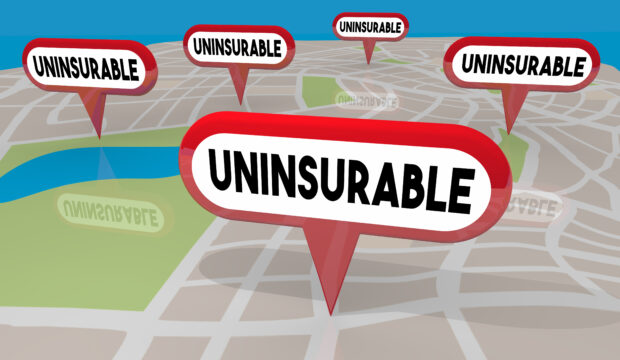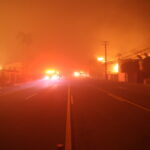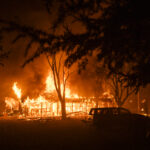Why isn’t my ZIP code on the map?
Questions along those lines emerged at a public hearing hosted by the California Department of Insurance last week when CDI sought comments on proposed regulatory text that will allow insurance carriers to use catastrophe modeling in residential and commercial property rate filings.
In mid-June, CDI released the draft text, clarifying exactly where insurers have to write more homeowners insurance—and by how much—to qualify for the option.
For the most part, speakers representing the insurance industry and those from organized consumer groups put forth predictable objections to the regulatory language, echoing themes from past hearings. Insurers said the requirements to write more business in the state were too strict; consumer groups find them too lenient.
In the middle, homeowners and community supervisors scrutinized a map that CDI released with the draft text and offered new worries about missing areas of distress, and about what will happen when communities move off a map of such area but they still don’t have affordable insurance options.
Deputy Commissioner Lucy Wang revealed the map at the start of the hearing, highlighting the areas which the department identified as having higher concentrations of FAIR plan policies and wildfire risk. “The goal is to include as many areas of the state to provide relief to our hardest hit consumers. In some portions of the map, the areas include a whole county and in other areas it will be based on individual ZIP codes,” she said, giving a summary version of a more detailed definition of “distressed areas” presented in the draft regulatory text that refers to “high or very high fire severity” mapped by the Department of Forestry and Fire Protection (CAL FIRE) as well as combinations of high average premium and low per-capital income figures. “And if you are on the FAIR plan and your property is rated with moderate to very high wildfire risk, you are included,” she added, identifying a second group addressed by the regulation.
Four minutes later, a homeowner who said she has FAIR plan coverage after being dropped by an insurer that increased rates by 400 percent, was the first to observe that surrounding ZIP codes were on the distressed area map but hers was not. “Is there a reason why mine would not be here?” she asked, also noting that her ZIP code is listed as distressed for commercial properties.
“Today is not a question-and-answer period,” Wang said, offering to take note of the information anyway for follow-up.
But questions like that kept coming—from several frustrated policyholders who asked why insurers dropped them even though they engaged in mitigation activities, from a man who said he found insurance but was forced to bundle auto and home, from the representative of a cannabis association who said his members are denied access to the FAIR plan, and others.
“Do you have any comments directly related to the proposed regulations?” Wang asked more than once.
Fire Chiefs Weigh In
The most common question, about map omissions, seemed to be answered by another commenter rather than a CDI representative. Dave Winnacker, Fire Chief for the Moraga-Orinda fire district, explained that outdated CAL FIRE maps used as a starting point for the draft’s definition of distressed areas don’t reflect current wildfire conditions. “The adoption of fire hazard severity zones differs in local responsibility areas [LRAs] and state responsibility areas [SRAs],” Winnacker reported, noting that LRAs are areas within incorporated city limits “where the majority of California residents live,” while SRAs are “non-federal grass, brush and timber covered lands outside municipal limits.”
Although SRA maps were updated in April 2024 to include moderate, high and very high zones reflecting current conditions, LRA maps, “in sharp contrast,” were last updated in 2009 and only include very high zones. While draft LRA maps published two years earlier, in 2007, included both high and very high zones, the final maps suppressed high zones in LRA.
“As a result, the proposed regulation effectively discriminates against residents in LRA.”
“The practical effect of this disparate treatment can be seen within my fire district, where LRA Orinda, having just experienced a nonrenewal of 22.7 percent of homes with State Farm’s announcement [in March], is not included, while SRA Canyon is included as a distressed ZIP code, even though it has very similar nonrenewal rates,” Winnacker reported, urging CDI to use the 2007 draft maps with high fire hazard severity zones included until new LRA maps are published.
(Editor’s Note: The virtual hearing took place a day before California local news outlets were reporting that State Farm General is seeking a hefty rate increase under current filing rules, prompting CDI to question the financial viability of the California carrier in the industry’s biggest insurance group. See related articles, “State Farm Seeking Large Rate Increases in Wildfire-Prone California,” July 3, 2024 and “State Farm Update: More ‘Difficult but Necessary’ Decisions in California, March 20, 2024)
Fire experts like Winnacker also testified that while regulatory reforms are moving in the right direction to stabilize insurance markets, they are not enough. “Long term stability and affordability will only be achieved if we lose fewer homes to wildfire,” Winnacker said, urging CDI to include adoption of various loss mitigation approaches—at least those previously outlined in CDI’s 2022 “Safer From Wildfires” framework—as one of the criteria through which ZIP codes and counties are included as distressed.
“The science is crystal clear that at the community level, we have agency to reduce wildfire risk using CDI’s recommendations, and the department should recognize those who have done so by insuring their access to coverage,” he said.
“We’re in a big catastrophe,” Kimberly Giuliacci, Division Chief and Fire Marshall with Woodside Fire Protection districts, said somewhat fittingly toward the end of the two-hour virtual public hearing about when insurers will be allowed to use catastrophe modeling. Like Winnacker, she offered observations about the fitness of 15-year-old maps and urged greater communication between fire chiefs and insurance carriers about mitigation efforts.
“When I go out and actually do those inspections, it’s people who are completely in compliance with defensible space requirements” that are being nonrenewed.
“There’s no communication with the local authorities here. We’re doing the assessments. We’re [imposing] a lot of stringent requirements, and it’s not helping. It’s very difficult for us to enforce… when [homeowners] are getting dropped [by insurers] even when they do comply.”
Related article: Winnacker and several other fire chiefs teamed up with Nancy Watkins, a principal Milliman, to write an article about collaborations with the insurance industry for Carrier Management last year: ” A Community-Based Solution: How Actuaries and Fire Chiefs Can Tackle WUI Risk Together)
The 85 Percent Standard—and the Exceptions
When CDI Commissioner Ricardo Lara announced a promised package of regulatory reforms known as the “Sustainable Insurance Strategy” in September last year, he described a “historic agreement between the department and insurance companies.” In exchange for permission to use catastrophe models and to include California-only reinsurance costs in ratemaking, “insurance companies will write no less than 85 percent of their statewide market share in wildfire distressed areas” and commit to depopulating the FAIR plan,” he said at a news conference at the time.
Beyond providing a multipart definition of “wildfire distressed areas,” the draft text released for public comment last month finally answers a question that stakeholders have asked since he said that: How is the 85 percent standard calculated and met?
Essentially, insurers have two years after their rate filing is approved to show that they have written at least the number of policies in distressed areas indicated by the following formula: Multiply an exposure-based statewide market share figure by 0.85 and by the department’s recorded estimate of the total number of earned exposures of qualifying residential property insurance (voluntary and FAIR plan insurance) inside distressed areas.
Statewide market share is the insurer’s earned exposures written in residential property polices across the state divided by earned exposures for all qualifying residential insurance.
The exposure totals—distressed areas and statewide—are based on the most recent experience year, which is now the year ended Dec. 31, 2023 (a date when the market looked much different than it did five years earlier, one commented noted).
But some new wrinkles popped up in the draft text, describing ways for insurers to meet their commitments without meeting that 85 percent standard. In lieu of the 85 percent standard, “insurers with a smaller existing presence in distressed areas will need to increase their writings [in those areas] by at least 5 percent. The proposed regulation allows flexibility for companies to include FAIR Plan policies from all areas of the state with wildfire risk in the demonstration of a 5 percent increase,” Wang told hearing participants, also noting that for commercial properties, “commercial insurance companies must also increase writing by 5 percent in ZIP codes that overlap with high and very high wildfire hazard areas.”
Yet, while a press release announcing the hearing also indicates that the “5 percent increase” pathway is only available to “smaller companies, new entrants, and [regional] companies that largely write outside of wildfire risk areas and cannot meet the 85 percent requirement,” the draft regulatory language itself does not make any size distinction.
That inconsistency caught the attention of consumer advocates, including Carmen Balber, executive director of Consumer Watchdog, who flagged this as a “loophole” during her remarks at the hearing.
“The regulation does not require [all] insurance companies to expand sales in fire areas to 85 percent of their market share in the rest of the state. This is in direct contradiction to what the Commissioner has said….They could opt to increase their market share by just 5 percent in high fire zones, or they could make an alternative commitment that has no definition at all in the regulation,” Balber said, referring to additional language near the end of the draft that provides for an insurer that “is unable, in good faith” to meet either the 85 percent standard or the 5 percent increase rule to “propose an alternative” owing to its size, scope of coverages or frequency or severity of recent events impacting its results.
More Clarity Needed
While Balber also noted that the text is does not spell out the penalties for insurers that don’t meet the outlined commitments, representatives of the insurance industry expressed the need for clarity in other areas.
Over time, “if areas are determined to no longer be distressed, how might those policies written in these [distressed] areas potentially count towards an insurer’s [ongoing] commitment?” asked Karen Collins, vice president of property and environmental for the American Property Casualty Insurance Association.
Collins continued: “APCIA is also concerned about the ability of insurers to fulfill the insurer commitments due to various and unique business models, size and financial condition as well as current FAIR plan pricing in relation to coverage options available via the private market. For example, there is uncertainty if CDI’s intent is to require FAIR plan policyholders and brokers to move coverage to a private market insurer if coverage is offered, particularly coverage from the FAIR plan remains significantly underpriced in relation to the private market.”
She also referred to the “alternative commitment” language suggesting that that particular offramp should be available for insurers with potential solvency risks, and referenced a “low premium volume” exception—available to carriers writing less than $10 million of gross annual premiums for residential property—stating that none of the 125 companies writing homeowners insurance in California would meet that threshold.
Later, Stephen Young, senior vice president and general counsel for the Independent Insurance Agents & Brokers of California recommended raising that threshold from $10 million to $50 million. “We believe that the 85 percent benchmark that has been suggested in this regulation is too high,” he added, referring to written testimony that proposed lowering it to 66 percent.
Speaking on behalf of the National Association of Mutual Insurance Companies and Personal Insurance Federation of California, Seren Taylor raised concerns about language indicating that CDI will update its lists of distressed areas every year. “It’s not clear to us how an insurer can meet a commitment to achieve 85 percent of its statewide market share within two years, or maintain 85 percent of its market share for three years, if the defined distressed area is changing every year.” Taylor suggest that insurers’ commitments be based on the defined distressed areas at the time of the filing, and that defined distressed areas be updated on a three-year cycle rather than every year.
A speaker who identified herself as an insurance agent had a totally different concern. “I have run into companies writing insurance policies, going out, doing an inspection, turning around and canceling them….. Are they meeting their percentage?” she asked, referring to the 85 percent standard.
Speed of implementation was on the minds of other speakers too. “I’d be remiss if I didn’t that there’s a high degree of concern regarding the ability to accomplish the ambitious goals of the Sustainable Insurance Strategy without more certainty and expediency in the rate filing process,” said Taylor, referring to support of a trailer bill introduced by California Governor Gavin Newsom in May to speed up rate filing approval timelines.
Related article: New Language in California Budget Seeks to Expedite Insurance Rate Filing
Permission to Innovate
For consumers, change can’t happen fast enough.
“The concern that I have is the rate of nonrenewals is so brisk at this point,” and that it’s going to take quite a while to put the regulations into effect, said one fire chief, suggesting that a moratorium on nonrenewals be considered “to basically stop the bleeding that’s going on in the system so that the residents, this pool of people that are nonrenewed will be more finite than infinite.”
Lara’s department faces a formidable task of tying everything together.
“It is extremely difficult, as the department knows, to be an innovator in a stodgy topic like insurance. That’s what I see the commissioner attempted to do here,” said Ken Cooley, a former state lawmaker speaking at the hearing as a private citizen, albeit one that analyzed California’s prior-approval law, Proposition 103, in 1988.
While bound to comply with an existing body of law, under Prop 103, Lara does have considerable flexibility,” Cooley stated. “The ability to try to get his arms around a problem, get it down to a manageable size, Prop 103 itself provided it can be liberally construed [and] ‘applied to promote its underlying purposes.’ And that to me is what the Commissioner needs to do and is doing.”
“This issue is so much bigger than insurance. It affects housing availability, affordability, the viability of small business….It affects what consumers have to spend and this is vital to our economy as a whole,” Cooley said, describing what he views as the Commissioner’s challenge. “Under Prop 103, an applicant has the burden of proving their request for rate change is justified. [I] actually see this [Prop 103] language as supporting the exercise of discretion by Commissioner Lara on a case-by-case basis—analyzing how the rules apply, how the models work, to evaluate rates. I think he has flexibility. That’s within his charge.”
In July, in addition to tackling the promise of allowing insurers to include consideration California-specific reinsurance costs in rate filing applications, Lara also plans to require the FAIR plan to increase coverage for larger homeowners’ associations, condo associations, farms, and other businesses– to $20 million per structure. In addition, the department said, he will require the FAIR plan to have a sounder financial sustainability structure.
Related article: Raise a Glass to Cat Models: More California Hearing Deets





















 What to Expect in 2026: U.S. P/C Results More Like 2024
What to Expect in 2026: U.S. P/C Results More Like 2024  Viewpoint: Mapping Evolving Regulatory Terrain for MGAs, MGUs and Other DUAEs
Viewpoint: Mapping Evolving Regulatory Terrain for MGAs, MGUs and Other DUAEs  Women Are Now Leaning Out in the Workplace
Women Are Now Leaning Out in the Workplace  Chubb, The Hartford, Liberty and Travelers Team Up on Surety Tech Co. Launch
Chubb, The Hartford, Liberty and Travelers Team Up on Surety Tech Co. Launch 











